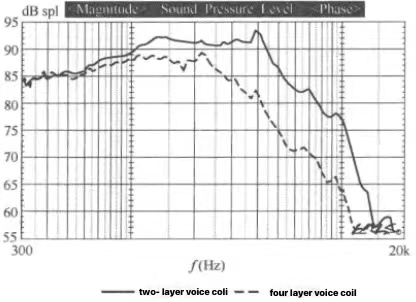The noticeable difference in response caused by the voice coil is related to how the voice coil is wound. Obviously, larger voice coils with longer winding lengths have more turns and thus more inductance. This power induction has the same effect as the series’s in the crossover, it will attenuate the response at the high frequency. Various combinations of the number of windings, the diameter of the bobbin, and the magnetic conducting column have different induction of the voice coil, and the number of layers of the coils wound on the bobbin plays a decisive role in the difference in the inductance of the speaker unit. The most common coil layers in low-frequency units are 2 and 4 layers. In order to obtain the Bl value required to reach the target response, ultra-low drivers often use 4-layer wire voice coils.

However, this can also be seen as a control of the high-frequency end response. The graph shown above compares the frequency response of two essentially identical 5.5″ subwoofers with the same magnetic circuit, cone, and support system, but with one using a 2-layer voice coil and the other using a 4-layer voice coil. It can be seen that the low-pass attenuation frequency (-3dB, 2.5kHz) of the unit using the 4-layer voice coil is much lower than that of the 2-layer voice coil (-3dB, 4.5kHz). Some manufacturers take advantage of this feature of the 4-layer voice coil, by controlling its inductance to produce a natural low-pass attenuation, which can be matched with a specific tweeter, and developed some 2-way speakers. In this way, the woofer does not require a separate low-pass filter section to be connected “thru” with a crossover consisting only of the tweeter’s high-pass filter.
For manufacturers, using a 4-layer voice coil has the advantages of fewer crossover components and lower cost. Another difference is that the overall sensitivity is 2-3dB lower due to the larger mass of the 4-layer voice coil, which is the price it pays.
